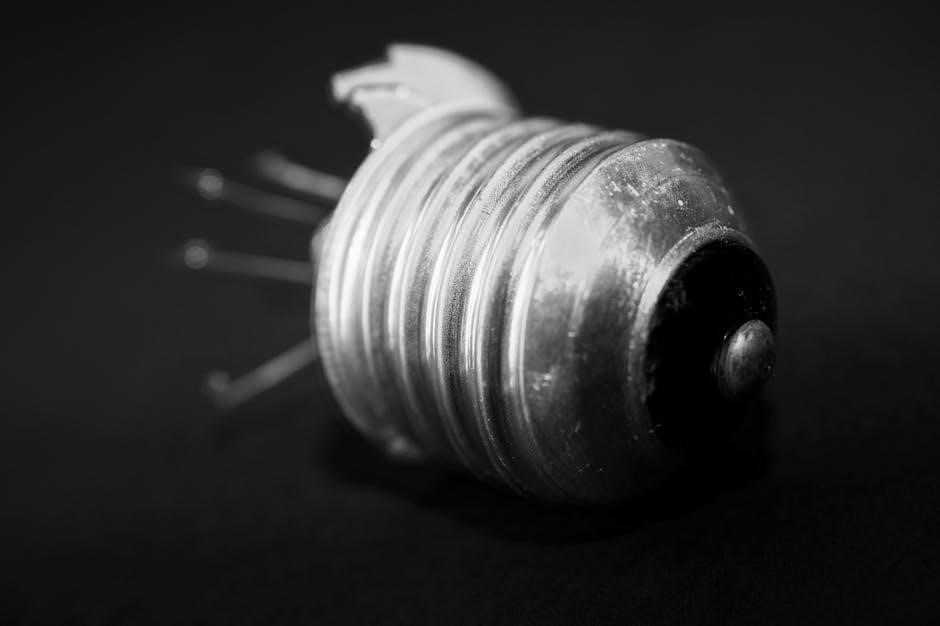Lubrication failure is a critical issue affecting machinery longevity, often caused by improper techniques, contamination, or incompatible lubricants, leading to increased wear, overheating, and premature system failure.
1.1 Definition and Importance of Lubrication
Lubrication refers to the process of reducing friction between moving surfaces by introducing a lubricant, such as oil or grease, to minimize wear and tear. It also acts as a coolant and sealant, preventing overheating and contamination. Proper lubrication is essential for extending equipment life, enhancing operational efficiency, and preventing premature failures. In mechanical systems, lubrication plays a critical role in maintaining performance, reducing energy consumption, and ensuring smooth operation. Without effective lubrication, machinery would suffer from increased wear, overheating, and eventual breakdown, leading to costly repairs and downtime. Thus, lubrication is a cornerstone of industrial maintenance.
1.2 Consequences of Lubrication Failure
Lubrication failure leads to increased friction between moving parts, causing excessive wear and tear. This results in overheating, surface fatigue, and premature component failure. Machinery experiences reduced performance, operational inefficiency, and eventual shutdown. Lubrication failure also accelerates contamination, as damaged surfaces become vulnerable to debris ingress. The economic impact is significant, with costly repairs, downtime, and potential replacement of entire systems. In critical applications, such as engines or turbines, failure can lead to catastrophic damage, safety risks, and environmental hazards. Addressing these consequences underscores the importance of proper lubrication practices and maintenance.

Causes of Lubrication Failure
Lubrication failure often stems from improper mounting techniques, contamination, or using incompatible lubricants. These factors disrupt the lubrication system, leading to mechanical inefficiencies and potential damage.
2.1 Improper Mounting Techniques
Improper mounting techniques are a leading cause of lubrication failure. Misalignment, overloading, or incorrect installation can damage bearings and disrupt the lubrication system. This often leads to increased wear, overheating, and premature failure.
Improper mounting can cause uneven stress distribution, accelerating component degradation. Additionally, it can introduce contaminants or disrupt the lubricant film, further exacerbating the issue. Proper training and precision are essential to prevent these errors and ensure optimal system performance. Neglecting proper mounting practices can result in costly downtime and premature system failure.
2.2 Contamination of Lubricants
Contamination of lubricants is a significant contributor to lubrication failure. Foreign particles, moisture, or chemicals can degrade lubricant quality, reducing its effectiveness and leading to premature wear.
Contaminants can enter through improper handling, insufficient filtration, or environmental exposure. Once present, they can cause surface fatigue, particle denting, and eventual component failure. Regular filtration and strict contamination control measures are essential to maintain lubricant integrity. Neglecting these practices can result in costly repairs, downtime, and reduced system lifespan; Contamination is a preventable yet pervasive issue in lubrication management.
2.3 Incompatible or Incorrect Lubricants
Using incompatible or incorrect lubricants is a common cause of lubrication failure. Different operating conditions require specific lubricants, and mismatches can lead to inadequate performance.
Incompatible lubricants may fail to provide sufficient friction reduction, leading to increased wear, overheating, and premature component failure. Additionally, using the wrong viscosity or type of lubricant can degrade its effectiveness over time. This can result in costly downtime, repairs, and reduced system lifespan. Proper lubricant selection, considering factors like temperature, load, and environmental conditions, is critical to prevent such failures and ensure optimal machinery performance.
Common Failure Modes
Lubrication failure often results in surface fatigue, particle denting, and overheating. These modes lead to increased wear, premature component damage, and systemic breakdowns, reducing machinery lifespan significantly.
3.1 Surface Fatigue and Particle Denting
Surface fatigue and particle denting are common failure modes caused by lubrication failure. Fatigue occurs due to repeated stress on surfaces, leading to micro-cracks and eventual material breakdown. Particle denting happens when contaminants or debris embed into surfaces, creating indentations that concentrate stress. Both phenomena weaken components, reducing their lifespan. Contamination and inadequate lubrication exacerbate these issues. Over time, these damages can lead to premature failure of bearings, gears, and other critical machinery parts. Regular lubrication maintenance and contamination control are essential to mitigate these failure modes and ensure optimal system performance and longevity.
3.2 Overheating Due to Inadequate Lubrication
Overheating is a common consequence of inadequate lubrication, occurring when insufficient lubricant fails to dissipate heat effectively. This leads to excessive friction, causing temperatures to rise beyond safe operating limits. Prolonged exposure to high heat degrades lubricants, reducing their effectiveness and accelerating wear. Components like bearings and gears become susceptible to premature failure. Contamination, improper lubricant viscosity, and insufficient cooling exacerbate this issue. Overheating can also result from heavy electrical loads or inadequate heat management systems. Regular monitoring of lubrication systems and maintaining optimal lubricant levels are critical to preventing overheating and ensuring machinery reliability.
3.3 Bearing Failures and Their Symptoms
Bearing failures often result from lubrication-related issues, such as inadequate lubrication, contamination, or improper lubricant selection. Symptoms include unusual noise, vibration, and increased operating temperatures. Over time, lack of proper lubrication leads to metal-to-metal contact, causing surface fatigue, pitting, or spalling. Particle denting and contamination marks on raceways can induce stress concentrations, accelerating fatigue failure. In severe cases, bearings may overheat, seize, or disintegrate, leading to catastrophic machinery shutdown. Regular monitoring of bearing condition and lubrication quality is essential to prevent premature failure and ensure smooth operation. Early detection of these symptoms can prevent costly downtime and repairs.

Consequences of Lubrication Failure
Lubrication failure leads to increased wear, overheating, and premature system failure, causing costly downtime, repairs, and potential economic losses due to reduced productivity and maintenance expenses.
4.1 Increased Wear and Tear
Lubrication failure accelerates wear and tear by allowing metal-to-metal contact, leading to surface fatigue and particle denting. This results in premature component damage, reduced performance, and frequent replacements. Contamination and improper lubricant selection exacerbate wear, causing overheating and material degradation. In machinery, gears and bearings are particularly vulnerable, as inadequate lubrication disrupts their smooth operation. Over time, this wear compounds, shortening equipment lifespan and increasing maintenance needs. Addressing lubrication issues early is critical to minimizing these effects and ensuring optimal system performance.
4.2 Premature System Failure
Premature system failure occurs when critical components like bearings, gears, and engines are no longer functional due to inadequate lubrication. This failure is often sudden and unexpected, leading to unplanned downtime and costly repairs. Lubrication failure accelerates wear on moving parts, causing overheating and metal-to-metal contact, which can irreparably damage machinery. For example, turbocharger failures in marine engines and bearing failures in wind turbines are commonly linked to poor lubrication practices. Such failures not only disrupt operations but also result in significant economic losses, emphasizing the importance of effective lubrication management to extend system lifespan and reliability.
4.3 Economic Impact of Downtime
Lubrication failure often leads to costly downtime, significantly impacting a company’s bottom line. Unplanned equipment shutdowns result in lost productivity, increased maintenance costs, and potential revenue losses. For instance, in manufacturing or shipping industries, a single incident of premature system failure can halt production lines or delay shipments, incurring substantial financial penalties. Additionally, the cost of repairing or replacing damaged components, coupled with the expense of troubleshooting and preventive measures, further exacerbates the economic burden. Such downtime underscores the critical need for robust lubrication management to mitigate financial risks and ensure operational continuity.

Prevention and Maintenance Strategies
Regular lubrication system inspections, proper lubricant selection, and contamination control are essential to prevent failures. Implementing scheduled maintenance programs ensures optimal equipment performance and longevity, minimizing downtime risks.
5.1 Proper Lubricant Selection
Proper lubricant selection is crucial to prevent machinery failure. Lubricants must align with operating conditions, load, and temperature. Viscosity and compatibility ensure optimal performance, reducing wear and tear. Incorrect choices lead to inadequate lubrication, causing overheating and premature failure. Regular assessments of lubricant properties and system requirements minimize risks. Proper selection extends equipment life and maintains efficiency, avoiding costly downtime and repairs. Always consult manufacturer guidelines to choose the right lubricant for specific applications, ensuring longevity and reliability in industrial operations.

5.2 Regular Lubrication System Monitoring
Regular monitoring of lubrication systems ensures optimal performance and prevents unexpected failures. Continuous checks involve analyzing lubricant condition, viscosity, and contamination levels. Vibration analysis and oil sampling help detect early signs of degradation or particle buildup. Monitoring also verifies lubricant flow rates and system temperatures, ensuring they remain within safe ranges. Timely interventions based on monitoring data prevent premature wear and overheating. This proactive approach minimizes downtime and extends equipment lifespan, ensuring smooth operation and reducing maintenance costs. Consistent oversight is vital for maintaining lubrication system health and avoiding catastrophic failures.
5.3 Contamination Control Measures
Contamination is a leading cause of lubrication failure, as foreign particles can degrade lubricants and damage surfaces. To mitigate this, implement filters in lubricant systems and ensure storage containers are clean. Regularly inspect and replace filters to prevent particle ingress. Use sealing systems on equipment to block dust and moisture. Cleanliness during lubricant handling is crucial to avoid introducing contaminants. Training staff on hygiene practices reduces contamination risks. These measures prevent premature wear, fatigue, and system failure, ensuring lubricants perform optimally and extending equipment lifespan.

Case Studies and Real-World Examples
Case studies reveal lubrication failure in marine engines and wind turbines, highlighting contamination and improper lubrication as root causes, emphasizing the importance of maintenance and monitoring.
6.1 Turbocharger Failures in Marine Engines
Turbocharger failures in marine engines often stem from lubrication-related issues; Contamination of lubricating oil, either by fuel or water ingress, is a primary cause. Overheating due to inadequate lubrication can lead to bearing damage and turbocharger seizure. High-stress operating conditions exacerbate these failures, resulting in costly repairs and downtime. Regular maintenance, including oil analysis and proper lubrication practices, is critical to preventing such failures. These incidents highlight the importance of vigilant monitoring and adherence to lubrication best practices to ensure engine reliability and performance at sea.
6.2 Wind Turbine Bearing Failures
Wind turbine bearing failures are predominantly linked to lubrication issues. Inadequate lubrication leads to excessive friction, overheating, and premature wear. Contamination of grease by moisture or debris further accelerates bearing degradation. The remote location of wind turbines complicates maintenance, worsening the impact of such failures. Studies show that over 60% of wind turbine gearbox failures are due to bearing lubrication problems. Regular lubrication system inspections and contamination control measures are essential to mitigate these failures and ensure reliable operation of wind energy systems.
Best Practices for Lubrication Management
Implementing best practices involves selecting compatible lubricants, adhering to viscosity requirements, and maintaining strict contamination control. Regular monitoring and scheduled maintenance ensure optimal system performance and longevity.
7.1 Lubricant Compatibility and Viscosity
Selecting the right lubricant is crucial for machinery health. Compatibility ensures proper interaction with materials, while viscosity must match operating conditions to maintain film thickness and prevent wear. Improper choices can lead to premature failure. Regular testing and analysis of lubricant properties are essential to avoid breakdowns. Additionally, viscosity grades should align with temperature variations to maintain optimal performance. Proper lubricant selection extends equipment life and prevents downtime, making it a cornerstone of effective lubrication management strategies.
7.2 Scheduled Maintenance Programs

Regular maintenance is vital to prevent lubrication-related failures. Implementing scheduled programs ensures timely lubricant changes, system inspections, and contamination control. These practices help identify issues early, reducing downtime and extending equipment life. Proper record-keeping and training further enhance program effectiveness. Consistent monitoring of lubricant condition and machinery performance is key to maintaining operational efficiency and safety. By integrating these strategies, organizations can minimize unexpected failures and optimize overall system reliability, ensuring smooth and continuous operations across various industries.
